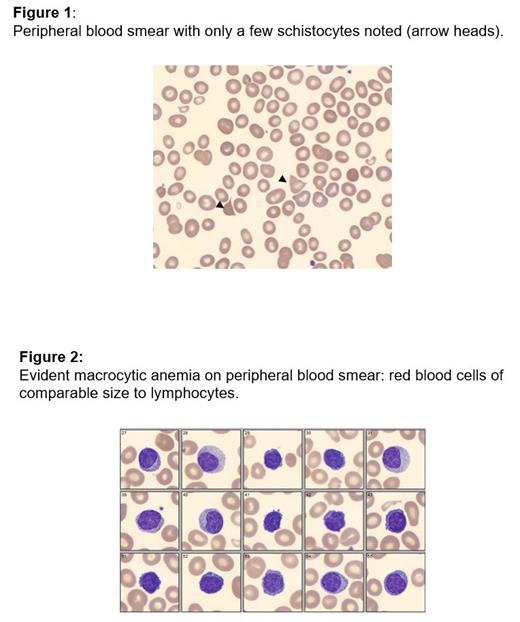Introduction:
Vitamin B12 and folate deficiencies are common etiologies of macrocytic anemia, mostly encountered with chronic alcohol use, and uncommon for healthy individuals with unremarkable medical history. The pathogenesis of the resulting anemia is described by two possible mechanisms: either ineffective erythropoiesis, driven by vitamin B12 deficiency, or more rarely, via nonimmune intramedullary hemolysis. We present a very rare case of severe vitamin B12 deficiency leading to nonimmune intramedullary hemolysis and highlight the diagnostic evaluation and tailored management.
Case Presentation:
A 49-year-old female with history of depression, chronic alcohol use and chronic nitrous oxide inhalation, presented with lethargy, hypotension and fevers with visual hallucinations, and was subsequently admitted for acute encephalopathy. Findings on physical examination included diminished proprioception and diminished sensation to fine touch, pinprick and vibration of the lower extremities with distal hyperreflexia of the patellar and Achilles tendon reflexes bilaterally. Lab work was notable for leukopenia and macrocytic anemia with a significant drop in hemoglobin to 9.6 from a baseline of 13.2 within 5 months and MCV of 103. Extensive investigation of encephalopathy was undertaken, of which we note infectious workup, prompted by the septic presentation, which showed Staphylococcus aureus bacteremia. On the other hand, the patient's anemia was concurrently investigated. Hemolysis workup was positive (LDH 394 U/L; direct bilirubin 1.6 mg/dL; haptoglobin<8 mg/dL; reticulocyte count 6.1%); however, schistocytes were low on peripheral smear (Figures 1 and 2). As such, nonimmune intramedullary hemolysis was suspected. Further anemia workup revealed severe vitamin B12 deficiency (75 ng/L), consistent with the physical exam findings, but normal folate levels. Of note, methylmalonic acid levels and homocysteine were also elevated (respectively 4.39 nmol/mL, and 142 umol/L). The constellation of the clinical presentation and all the laboratory findings confirmed a nonimmune intramedullary hemolytic process, elicited by vitamin B12 deficiency. This deficiency was thought to be multifactorial, mainly caused by chronic alcohol abuse, in addition to persistent nitrous oxide use. It was also suggested that hemolysis could be a consequence of drug-induced carboxyhemoglobinemia (level was 9.4%), whereby carboxyhemoglobin can form during the binding and release of nitric oxide from hemoglobin. Treatment was focused on replacing vitamin B12 with 1000 mcg daily intramuscular injections for 7 days, then weekly thereafter for 4 weeks, followed by monthly injections. Improvement of hemoglobin to 11.1 with improvement of neurologic exam findings were noted prior to discharge.
Conclusion:
Nonimmune hemolytic anemia must be included in the differential diagnosis when evaluating patients with anemia concurrent with vitamin B12 deficiency, mostly encountered with chronic alcohol use. Vitamin B12 supplementation remains the key treatment to correct this rare, but serious outcome of vitamin B12 deficiency.
Disclosures
Cherry:BMS: Speakers Bureau; Sanofi: Consultancy, Speakers Bureau.


This feature is available to Subscribers Only
Sign In or Create an Account Close Modal